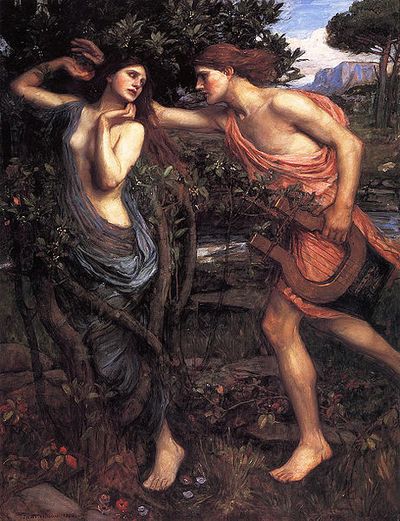Annotation:Daphne: Difference between revisions
No edit summary |
No edit summary |
||
| (6 intermediate revisions by 2 users not shown) | |||
| Line 1: | Line 1: | ||
---------- | |||
---- | {{TuneAnnotation | ||
|f_tune_annotation_title=https://tunearch.org/wiki/Annotation:Daphne > | |||
'''DAPHNE'''. AKA and see "[[Hit and Miss]]." English, Air and Jig (6/8 or 3/4 time). E Minor (Karpeles, Raven): D Minor (Chappell). Standard tuning (fiddle). AAB (Raven): AABBC (Chappell, Karpeles). The air was published by John Playford in the first edition of his '''English Dancing Master''' (London, 1651) and retained in the next two editions in 1652 and 1657, after which it appeared in the '''Dancing Master''' as "Daphne or The Shepherdess" (through the 8th edition of 1690). | |f_annotation='''DAPHNE'''. AKA and see "[[Hit and Miss]]." English, Air and Jig (6/8 or 3/4 time). E Minor (Karpeles, Raven): D Minor (Chappell). Standard tuning (fiddle). AAB (Raven): AABBC (Chappell, Karpeles). The air was published by John Playford in the first edition of his '''English Dancing Master''' (London, 1651) and retained in the next two editions in 1652 and 1657, after which it appeared in the '''Dancing Master''' as "Daphne or The Shepherdess" (through the 8th edition of 1690). | ||
<br> | <br> | ||
<br> | <br> | ||
[[File: | [[File:daphne2.jpg|400px|thumb|left|John William Waterhouse: Apollo and Daphne - 1908]] | ||
However, "Daphne" was older than Playford, and appears to have been the tune for a 17th century ballad based on the ancent Greek myth, retold by Hellenistic and Roman authors in the form of an amorous vignette, regarding Apollo's pursuit of the nymph Daphne, who escaped only by turning herself into a tree. It is known that the melody was a great favorite in Elizabethan times [Ian Payne, '''The Almain in Britain'''], along with others found in Playford; "[[Heart's Ease (1)]]," "[[Greenwood]]" and "[[Wooddicock]]." "Daphne" also appears in the '''Fitzwilliam Virginal Book''' (with variations by composer Giles Farnaby), Adriaen Valerius' '''Nederlandtsche Gedenck-clanck''' (1626), J.J. Starter's '''Friesche Lust-Hof '''(1621), Jacob van Eyk's '''Fluyten Lust-Hof (1654, as "Doen Daphne"), and ''' | However, "Daphne" was older than Playford, and appears to have been the tune for a 17th century ballad based on the ancent Greek myth, retold by Hellenistic and Roman authors in the form of an amorous vignette, regarding Apollo's pursuit of the nymph Daphne, who escaped only by turning herself into a tree. It is known that the melody was a great favorite in Elizabethan times [Ian Payne, '''The Almain in Britain'''], along with others found in Playford; "[[Heart's Ease (1)]]," "[[Greenwood]]" and "[[Wooddicock]]." "Daphne" also appears in the '''Fitzwilliam Virginal Book''' (with variations by composer Giles Farnaby), Adriaen Valerius' '''Nederlandtsche Gedenck-clanck''' (1626), J.J. Starter's '''Friesche Lust-Hof '''(1621), Jacob van Eyk's '''Fluyten Lust-Hof''' (1654, as "Doen Daphne"), and Forbes' '''Cantus of Songs and Fancies''' (1662, 1666, and 1668, Aberdeen, Song XXI, a parody). Words to the tune can be found in the '''Roxburghe Collection''', Giles Earle's '''Song-book''' (1626), and Deloney's '''Royal Garland of Love and Delight''' (1674). | ||
|f_source_for_notated_version= | |||
|f_printed_sources=Christian ('''The Playford Assembly'''), 2015; p. 23. Karpeles & Schofield ('''A Selection of 100 English Folk Dance Airs'''), 1951; p. 17 (appears as "Hit and Miss"). Raven ('''English Country Dance Tunes'''), 1984; p. 24 & p. 40. | |||
|f_recorded_sources=Harmonia Mundi 907101, The King's Noyse - "The King's Delight: 17c. Ballads for Voice and Violin Band" (1992). Maggie's Music MMCD216, Hesperus - "Early American Roots" (1997). | |||
|f_see_also_listing= | |||
}} | |||
------------- | |||
---- | |||
Latest revision as of 21:44, 13 August 2020
X: 1
T:Daphne. (p)1651.PLFD.020
T:Shepherdess,The. (p)1651.PLFD.020
M:6/4
L:1/4
Q:3/4=90
S:Playford, Dancing Master,1st Ed.,1651.
O:England
H:1651.
Z:Chris Partington.
K:F
D|:F2 G A2 d|c>de d2A/B/|cAF GEC|DFE D3:|
|:f2 f e2 e|d>ed c A2|c>BAG2 F|F E2 F3|
|:ccd cAF|cd/e/f gec|A>GF E2 D|
ddc dAA|c>BA GDF|E>FE D3:|
DAPHNE. AKA and see "Hit and Miss." English, Air and Jig (6/8 or 3/4 time). E Minor (Karpeles, Raven): D Minor (Chappell). Standard tuning (fiddle). AAB (Raven): AABBC (Chappell, Karpeles). The air was published by John Playford in the first edition of his English Dancing Master (London, 1651) and retained in the next two editions in 1652 and 1657, after which it appeared in the Dancing Master as "Daphne or The Shepherdess" (through the 8th edition of 1690).

However, "Daphne" was older than Playford, and appears to have been the tune for a 17th century ballad based on the ancent Greek myth, retold by Hellenistic and Roman authors in the form of an amorous vignette, regarding Apollo's pursuit of the nymph Daphne, who escaped only by turning herself into a tree. It is known that the melody was a great favorite in Elizabethan times [Ian Payne, The Almain in Britain], along with others found in Playford; "Heart's Ease (1)," "Greenwood" and "Wooddicock." "Daphne" also appears in the Fitzwilliam Virginal Book (with variations by composer Giles Farnaby), Adriaen Valerius' Nederlandtsche Gedenck-clanck (1626), J.J. Starter's Friesche Lust-Hof (1621), Jacob van Eyk's Fluyten Lust-Hof (1654, as "Doen Daphne"), and Forbes' Cantus of Songs and Fancies (1662, 1666, and 1668, Aberdeen, Song XXI, a parody). Words to the tune can be found in the Roxburghe Collection, Giles Earle's Song-book (1626), and Deloney's Royal Garland of Love and Delight (1674).

